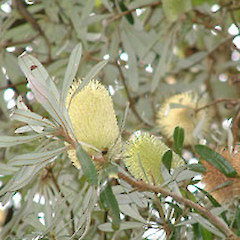Banksia integrifolia
Common name
banksia
Family
Proteaceae
Flora category
Vascular – Exotic
Structural class
Trees & Shrubs - Dicotyledons
NVS code
The National Vegetation Survey (NVS) Databank is a physical archive and electronic databank containing records of over 94,000 vegetation survey plots - including data from over 19,000 permanent plots. NVS maintains a standard set of species code abbreviations that correspond to standard scientific plant names from the Ngä Tipu o Aotearoa - New Zealand Plants database.
BANINT
Conservation status
Not applicable
Habitat
Terrestrial. Threat to well drained sites, e.g.. sand dunes.
Detailed description
Large shrub or small tree to about 10 m high. Leaves narrowly elliptic with densely serrate margins. Deep shining green above and white beneath. Inflorescence mostly 9-12 cm long, erect, forming a broadly cylindrical cone, pale green or pale greenish yellow. Fruiting cone woody, with brown felty indumentum persisting in lower part, valves opening widely to expose seed. Cones may persist on the tree a long time after flowering.
Similar taxa
Banksia species are quite distinctive within the Proteaceae, as the flower spikes consist of hundreds of tubular flowers arranged in rows. There are several Banksia species in New Zealand, B. integrifolia can be identified by the yellow-greenish yellow inflorescences and the obovate leaves 4-10 cm long, woolly underneath.
Flowering
May, June, July
Flower colours
Green, Yellow
Life cycle
Long-lived tree. Spreads by seed. Many seeds are produced, may require fire for mass germination. Dispersed by people, gravity, possibly expulsion during fire
Year naturalised
1990
Origin
Australia (Queensland, New South Wales, Victoria and northern Tasmania)
Reason for introduction
Horticultural.
Tolerances
Tolerant of a wide range of habitats and conditions from saline soils and estuaries, through dune field to subalpine tussock grassland
Etymology
banksia: Named after Sir Joseph Banks, 1st Baronet, GCB, PRS (24 February 1743 - 19 June 1820) was an English naturalist, botanist and patron of the natural sciences.













